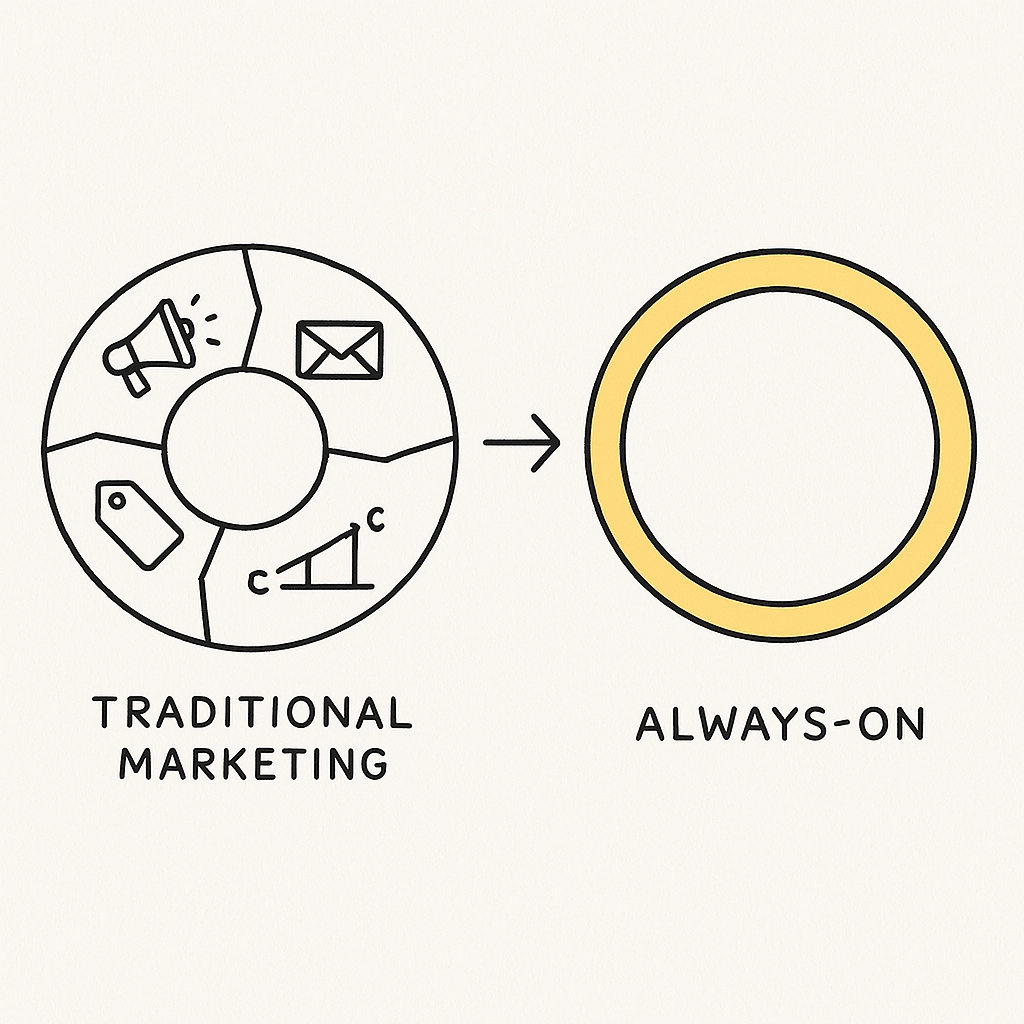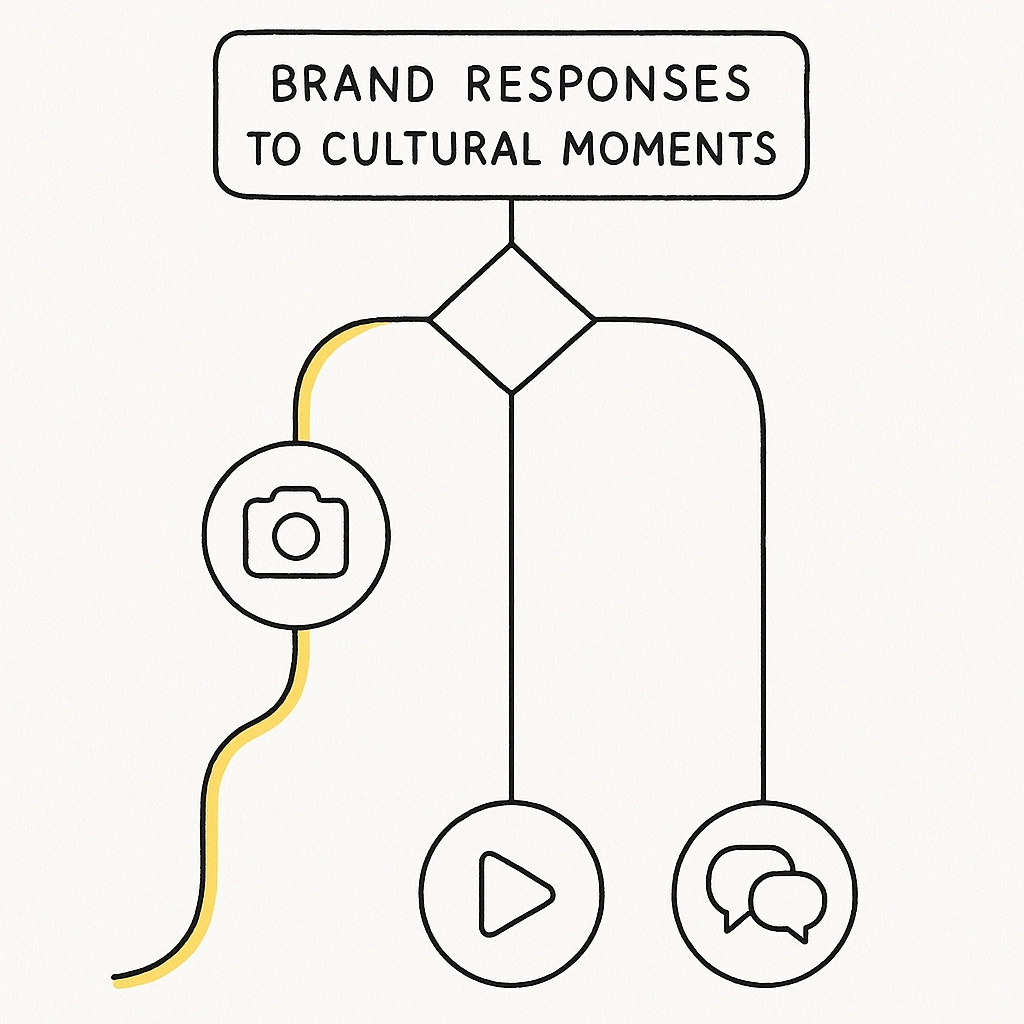The Death of the Campaign Calendar (And Why That's a Good Thing)
Remember when marketing meant planning quarterly campaigns, spending weeks in production, then crossing your fingers hoping your audience would catch your message during its brief moment in the spotlight?
Those days are officially over.
In 2025, the most successful brands have embraced what we're calling "Always-On" creative—a continuous, responsive approach to content creation and distribution that keeps brands relevant 24/7/365. Rather than the traditional "launch and forget" campaign model, today's powerhouse brands maintain constant conversations with their audiences.
But what exactly does "Always-On" look like in practice? Let's dive into what marketing leaders like Nike and PepsiCo are doing right now, and what your brand can learn from their playbooks.
What "Always-On" Really Means in 2025
"Always-On" isn't just posting more frequently on social media. It's a fundamental shift in how brands approach content creation, distribution, and engagement:
-
Continuous vs. Campaign-Based: Traditional marketing operated in distinct campaign cycles with clear beginnings and endings. "Always-On" means creating an uninterrupted stream of relevant content.
-
Responsive vs. Scheduled: Rather than adhering strictly to content calendars, successful brands now dynamically respond to cultural moments, audience signals, and performance data.
-
Iterative vs. Fixed: Content is treated as living, constantly evolving material rather than finished, unchangeable assets.

The Nike Playbook: Community-Powered Content Engines
Nike has mastered the art of letting its community fuel its "Always-On" strategy. Their approach includes:
1. Modular Content Architecture
Nike doesn't create standalone campaigns anymore. Instead, they develop content systems with interchangeable parts that can be remixed, repurposed, and redeployed based on performance data.
For example, their 2025 "Move Different" initiative includes:
- Core brand video assets broken into dozens of 5-15 second snippets
- Product photography shot specifically for multiple aspect ratios
- Athlete stories captured in formats optimized for each platform
This modular approach allows Nike to maintain freshness without constantly starting from scratch.
2. Community Co-Creation
Nike's "Studio" platform invites everyday athletes to contribute content that Nike can amplify. This user-generated content strategy accomplishes multiple goals:
- Creates authentic, relatable content at scale
- Deepens community engagement
- Provides constant fresh material
- Surfaces unexpected creative directions
Nike's creative team reviews these submissions, selects standouts, and integrates them into their broader content ecosystem—sometimes within hours.
3. Micro-Moments Targeting
Instead of focusing solely on major sporting events, Nike identifies and creates content around micro-moments in athletes' lives:
- First 5K completions
- Personal records
- Rainy day runs
- Post-workout recoveries
By mapping these universal experiences, Nike maintains relevance throughout their customers' athletic journeys, not just during major campaigns.
The PepsiCo Method: Real-Time Cultural Relevance
PepsiCo has taken a different approach to "Always-On," focusing on cultural integration and rapid response:
1. Cultural Radar System
PepsiCo's dedicated "Cultural Insights Team" uses AI-powered social listening to identify emerging trends, conversations, and moments. They classify these as:
- Anticipated: Planned cultural events (awards shows, sports finals)
- Emerging: Rising trends with 2-4 week windows
- Immediate: Unexpected viral moments requiring same-day response
This system allows PepsiCo to participate in cultural conversations at the right moment—not a week later when the conversation has moved on.
2. Tiered Response Framework
Not every cultural moment deserves the same level of brand involvement. PepsiCo uses a tiered approach:
- Tier 1: Full creative response with custom assets
- Tier 2: Adapted existing creative with cultural references
- Tier 3: Simple engagement through comments or shares
This framework helps PepsiCo stay relevant without overextending resources or appearing desperate to join every conversation.
3. Cross-Platform Content Adaptation
PepsiCo doesn't just cross-post the same content everywhere. Their "Always-On" strategy includes platform-specific creative that respects each channel's unique environment:
- TikTok content emphasizes participatory challenges
- Instagram focuses on visual storytelling
- Twitter (now X) prioritizes conversational wit
- YouTube hosts longer-form content that builds deeper narratives

Social Media Trends Driving "Always-On" in 2025
Several key social media trends have accelerated the shift toward "Always-On" creative strategies:
1. The Collapse of Attention Windows
The average content consumption window has shrunk dramatically. In 2025, brands typically have less than 1.5 seconds to capture attention before users scroll past. This reality has forced brands to:
- Create more frequent, shorter content pieces
- Lead with the most compelling element
- Design for muted viewing
- Prioritize motion over static images
2. AI-Powered Creative Assistance
AI tools have democratized content creation, allowing even smaller brands to maintain "Always-On" strategies:
- AI-assisted copywriting for rapid ideation
- Automated video editing and adaptation
- Real-time performance optimization
- Predictive trend analysis
These tools help creative teams focus on strategy and big ideas while automating tactical execution.
3. The Authenticity Premium
As content volume has increased, so has audience skepticism. Brands in 2025 face an "authenticity premium"—content that feels genuine, unfiltered, and human dramatically outperforms polished, corporate messaging.
This trend explains why both Nike and PepsiCo have embraced user-generated content and more casual, in-the-moment creative approaches over traditional high-production campaigns.
How to Implement Your Own "Always-On" Strategy
Ready to shift your brand toward an "Always-On" approach? Here's how to start:
1. Audit Your Content Operation
First, evaluate your current content creation process:
- How long does it take from concept to publication?
- What bottlenecks slow down your creative process?
- How adaptable are your assets across platforms?
- What percentage of planned content actually gets produced?
Identifying operational friction points is the first step toward an "Always-On" system.
2. Build a Modular Content Framework
Following Nike's example, develop a system for creating content with reusable, adaptable components:
- Create shot lists that capture multiple formats simultaneously
- Design graphics templates that can be quickly customized
- Develop copy frameworks that can be easily adapted
- Build a searchable asset library for quick access
3. Implement a Response Protocol
Like PepsiCo, develop clear guidelines for how and when your brand should engage with cultural moments:
- Define what topics align with your brand values
- Establish approval workflows for time-sensitive content
- Create templates for common response types
- Set up monitoring systems for relevant conversations

4. Embrace Test-and-Learn Methodology
"Always-On" creative thrives on continuous improvement:
- Test multiple creative variations simultaneously
- Set clear success metrics for each content piece
- Analyze performance data daily, not monthly
- Apply learnings immediately to upcoming content
The Challenge of "Always-On": Avoiding Burnout and Noise
While "Always-On" offers tremendous advantages, it also presents challenges:
Creative Fatigue
Constant content creation can lead to team burnout and declining quality. Smart brands are:
- Building larger networks of creators rather than overworking core teams
- Using AI tools to handle repetitive tasks
- Creating "content holidays" where they rely on scheduled evergreen materials
- Developing rotation systems where different team members lead different initiatives
Audience Overwhelm
Consumers in 2025 are more selective than ever about what deserves their attention. To avoid contributing to digital noise:
- Focus on quality over quantity
- Ensure every piece provides genuine value
- Respect platform norms and user expectations
- Monitor engagement for signs of content fatigue
The Future of "Always-On": Where We're Heading
Looking ahead, "Always-On" creative will continue to evolve:
- Hyper-Personalization: Content will be increasingly tailored to individual preferences and behaviors
- Cross-Reality Experiences: Brands will need to maintain presence across physical, digital, and mixed reality environments
- Creator Ecosystems: The line between brand and creator will blur further as brands build networks of aligned voices
Conclusion: Starting Your "Always-On" Journey
The shift to "Always-On" creative doesn't happen overnight. It requires rethinking processes, tools, team structures, and success metrics. But brands that make this transition are seeing dramatic improvements in audience connection, relevance, and ultimately, business results.
The question isn't whether your brand should adopt an "Always-On" approach—it's how quickly you can make the shift before your more adaptive competitors leave you behind in the feed.
Ready to build your "Always-On" creative strategy? Contact us at 141 Creative to learn how we're helping brands develop content systems that keep them relevant every day of the year.


0 Comments